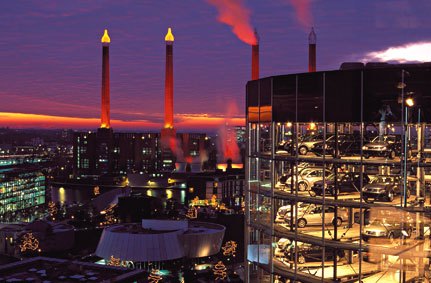No Easy Answers For A Powerless Japanese Car Industry

When you have a problem, there usually is no shortage of well-meant advice. When it emerged that power shortage is the biggest problem of the quake- and tsunami-stricken Japanese auto industry, or the Japanese industry as whole, good advice came pouring in. It ranged from “why don’t they just park an aircraft carrier by the dock” to “what’s wrong with using generators?” What’s wrong with them?
Apart from the fact that until yesterday, it was against the law to fire up a big generator outside a factory in Japan, and apart from the fact that generator makers are in the same quandary, with empty warehouses, and factories waiting for parts, there simply are no generators big enough to feed the industry’s appetite for power
To get an idea of how much power a car factory needs, I called on my old contacts at Volkswagen. Those iconic four smokestacks of the Wolfsburg factory are no factory smokestacks. They are the smokestacks of a coal burning power plant. They built that first. No power, no cars. Then, tucked away in the back of the Volkswagen factory is another, more modern power plant. Volkswagen Wolfsburg calls two power plants their own. I asked about the size of these plants. Volkswagen sent me a handy link to a website. When I opened it, my jaw dropped. Both plants produce electricity and heat. The combined output of both plants together is 1,375 Megawatt (MW).
What is the capacity of Fukushima Dai-ichi? Again, there is a handy website. According to Power-Technology.com, the combined output of all 6 reactor blocks is — 4.9 MW. Excuse me? Wikipedia to the rescue: It’s 4.7 Gigawatt, or 4,700 Megawatt, a simple three digit error. Which illustrates how hard it is to get decent information. Shades of microsievert and millisievert.
From Wikipedia, we learn that the Fukushima reactor blocks have an output between 460 and 1,100 MW. For simplicity’s sake, let’s call it 780 MW each. Volkswagen would need two of the nukes, with a little spare capacity to keep the lights on for the good folks in Wolfsburg, or to sell it up the grid.
Granted, as car factories go, Wolfsburg is a big one, the biggest in the world. Fukushima is was no slouch either. Again according to Wikipedia, Fukushima is “one of the 15 largest nuclear power stations in the world.” This exercise is simply meant to illustrate the magnitude of the problem, not to determine the capacity of each substation. By now it has become clear that to power a car factory, you need more than a few Honda gensets. Even if Toyota, Honda, Nissan would put nukes in their backyards (they will not), there still are Tier 1 suppliers. And Tier 2 suppliers. And Tier 3 suppliers.
You want an easy answer?
Its a mess that will haunt the industry for years.
Other than that, there are no easy answers.

Bertel Schmitt comes back to journalism after taking a 35 year break in advertising and marketing. He ran and owned advertising agencies in Duesseldorf, Germany, and New York City. Volkswagen A.G. was Bertel's most important corporate account. Schmitt's advertising and marketing career touched many corners of the industry with a special focus on automotive products and services. Since 2004, he lives in Japan and China with his wife <a href="http://www.tomokoandbertel.com"> Tomoko </a>. Bertel Schmitt is a founding board member of the <a href="http://www.offshoresuperseries.com"> Offshore Super Series </a>, an American offshore powerboat racing organization. He is co-owner of the racing team Typhoon.
More by Bertel Schmitt
Latest Car Reviews
Read moreLatest Product Reviews
Read moreRecent Comments
- Jrhurren Unions and ownership need to work towards the common good together. Shawn Fain is a clown who would love to drive the companies out of business (or offshored) just to claim victory.
- Redapple2 Tadge will be replaced with a girl. Even thought -today- only 13% of engineer -newly granted BS are female. So, a Tadge level job takes ~~ 25 yrs of experience, I d look at % in 2000. I d bet it was lower. Not higher. 10%. (You cannot believe what % of top jobs at gm are women. @ 10%. Jeez.)
- Redapple2 .....styling has moved into [s]exotic car territory[/s] tortured over done origami land. There; I fixed it. C 7 is best looking.
- TheEndlessEnigma Of course they should unionize. US based automotive production component production and auto assembly plants with unionized memberships produce the highest quality products in the automotive sector. Just look at the high quality products produced by GM, Ford and Chrysler!
- Redapple2 Got cha. No big.


































Comments
Join the conversation
Here's a 1990s view of the plant: http://www.youtube.com/watch?v=jmjyIU8Z4cw (I suppose that these links are allowed on TTAC?)
You don't miss your water 'til your well runs dry.